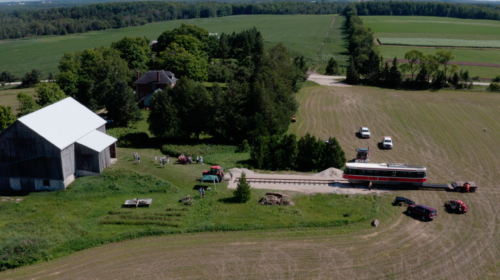New Grad Profile: Alexander Glista (MPlan’20)
 Graduating mid-pandemic definitely has it’s challenges. This past Spring new grad Alex Glista found himself walking across a virtual stage into an uncertain future. Like most new grads across the country and due to widespread pandemic restrictions, Alex was faced with a slow job market and limited networking opportunities.
Graduating mid-pandemic definitely has it’s challenges. This past Spring new grad Alex Glista found himself walking across a virtual stage into an uncertain future. Like most new grads across the country and due to widespread pandemic restrictions, Alex was faced with a slow job market and limited networking opportunities.
So, when the opportunity for a passion project emerged, Alex jumped on it! And in true Dal Planning style, the project is very unique – Alex was the successful bidder on a decommissioned 1981 TTC streetcar! Hear from Alex himself on the particulars of this project, how his education is helping him find fun and excitement in uncertain times, and his plans for the future!
Q: Tell us about your streetcar! What made you interested in owning it?
A: “I would say that after the CN Tower, the Toronto Transit Commission’s old red streetcars are the second most iconic Toronto symbol. As the backbone of the City’s surface transit fleet, they’ve carried hundreds of millions of passengers for both work and play. What made these vehicles, called “Canadian Light Rail Vehicles” or CLRVs, especially unique was the fact that they were designed specifically for Toronto – no other city in the world operated them. A CLRV weighs 50,000 lbs and is 50 feet long, so it’s much more substantial than a regular city bus.”
 “From a planning perspective, CLRVs also represent a very deliberate decision by Toronto to continue operating streetcars when the vast majority of North American cities were scrapping their systems. This decision ended up being the right one, as Toronto’s streetcar network is thriving and expanding today. As many other cities are now attempting to correct past decisions by building new light rail systems, Toronto’s history with streetcars has remained constant. Today, the city has the largest streetcar system in the Americas.”
“From a planning perspective, CLRVs also represent a very deliberate decision by Toronto to continue operating streetcars when the vast majority of North American cities were scrapping their systems. This decision ended up being the right one, as Toronto’s streetcar network is thriving and expanding today. As many other cities are now attempting to correct past decisions by building new light rail systems, Toronto’s history with streetcars has remained constant. Today, the city has the largest streetcar system in the Americas.”
“So when considering all of this rich history, and the fact that these vehicles helped to transport me around the city for most of my teenage and early adult years, how could I not have jumped at the opportunity to save such an important part of Toronto’s transit history?”
Q: How did you go about purchasing it?
A: “The TTC originally had 200 CLRVs in its fleet. They ended up keeping four for themselves, six were sent to a museum in Milton, Ontario, and three were sent to museums in Maine, Pennsylvania, and Illinois respectively. I ended up being the only “private” purchaser of one of these iconic transit vehicles.”
“Back at the end of July, I was on Facebook and noticed that someone had posted a link to a government auction website  where the TTC was selling off 10 CLRVs. There was about a week left before the bids were due, so I figured “what the heck, let’s see if this is possible”. I contacted a hauling company which works with the TTC to get a quote for moving the vehicle, and then I asked my parents if I could use our family farm as a resting place for the CLRV. The quote from the hauling company was reasonable, and most importantly, I got the green light from Mom and Dad to give a city transit vehicle a country home on “Glista Family Farms”. As a graduate of the MPlan program, I also checked the Grey Highlands zoning and bylaws to ensure that I wasn’t breaking any rules.”
where the TTC was selling off 10 CLRVs. There was about a week left before the bids were due, so I figured “what the heck, let’s see if this is possible”. I contacted a hauling company which works with the TTC to get a quote for moving the vehicle, and then I asked my parents if I could use our family farm as a resting place for the CLRV. The quote from the hauling company was reasonable, and most importantly, I got the green light from Mom and Dad to give a city transit vehicle a country home on “Glista Family Farms”. As a graduate of the MPlan program, I also checked the Grey Highlands zoning and bylaws to ensure that I wasn’t breaking any rules.”
“With 90 seconds left on the auction, I put a bid in for the minimum asking price. I decided to bid on CLRV #4187 as it seemed to be in the best condition. When I won the auction for #4187 as the only bidder, I was shocked. For someone who had never bought a car for themselves, winning an auction on a streetcar felt very surreal. I was ecstatic that my first vehicle was electric, however. After the shock had subsided, I was obviously very excited, but I knew that with only a month to remove the streetcar from TTC property, I had a lot of work to do.”
Q: How did your education influence you desire to do this? How did it prepare you for the task at hand?
A: “I would argue that my passion for transit and transportation planning led me to the Dalhousie School of Planning, and the training I received there helped me to execute my streetcar project. Two courses in particular taught me valuable skills relating to project management: PLAN 6000 (our independent project) and PLAN 6500 (our “capstone” group project). These two courses both featured large and complex reports as final deliverables. To successfully accomplish these tasks, one needed to stay on top of timelines, manage various stakeholders (clients, interviewees), and ensure that work was thorough and accurate.”
 “My streetcar project was extremely complex and had a very tight timeline of one month, but with my training I was able to pull it off. One of the most complicated elements was sourcing 60 feet of railway track materials to lay at my farm. To ensure that I stayed within budget, I was able to convince a short line railway to donate ties, while a railway supplier sold me rails from the 1930s at a discount. Moving the materials required teamwork, as my Dad and I had to drive all around Mid-Western Ontario to collect all of the required pieces. Building the railway track required accuracy, as the track had to be level, and spaced according to the TTC railway gauge, which is 4 foot 10 7/8 inches. In the end, I was able to build the railway track accurately, collaboratively, and efficiently within the one month timeline. When Streetcar 4187 rolled on to the track when it was delivered, I felt an immense sense of pride and accomplishment.”
“My streetcar project was extremely complex and had a very tight timeline of one month, but with my training I was able to pull it off. One of the most complicated elements was sourcing 60 feet of railway track materials to lay at my farm. To ensure that I stayed within budget, I was able to convince a short line railway to donate ties, while a railway supplier sold me rails from the 1930s at a discount. Moving the materials required teamwork, as my Dad and I had to drive all around Mid-Western Ontario to collect all of the required pieces. Building the railway track required accuracy, as the track had to be level, and spaced according to the TTC railway gauge, which is 4 foot 10 7/8 inches. In the end, I was able to build the railway track accurately, collaboratively, and efficiently within the one month timeline. When Streetcar 4187 rolled on to the track when it was delivered, I felt an immense sense of pride and accomplishment.”
Q: What have you done with it since it’s been on site? What are your ideas for its future?
A: “The first thing I did was give the streetcar a good sweeping. It left service in December 2019, and let’s just say the interior looked like it had winter wear and tear all over it. I have also built a split rail fence to help create an enclosure for it, built a gravel step up to the door, and planted grass seed all around it. Over the next few months I plan to give it a deeper cleaning, find a way to run electrical to it so I can power up the lights and gong, and to find ways to protect it from the winter weather.”
“In the future, I want Streetcar 4187 to become a magnet for friends and family to hang out in. I will keep the interior very similar to how it looked when it was in service, with only minor modifications to make it more comfortable. With its ample seating, watching movies in it would be a ton of fun also. I think it could be an excellent venue for photography, and I hope to find a way to be able to rent it out for that purpose. It also goes without saying that friends, faculty, and alumni from the Dalhousie School of Planning are always welcome to visit!”
Q: What is next for you?
A: “Due to the pandemic, I ended up moving back to Ontario from Nova Scotia in the spring. I miss the East Coast dearly, but I intend to stay in Ontario for the time being. I’m currently looking for my first full-time job, and can’t wait to work as a planner! With massive infrastructure projects and large-scale developments occurring in the Greater Toronto and Hamilton Area, I hope to be a part of a transformative project which will have positive planning implications for generations to come. Even though the job market has been difficult during COVID, I am optimistic for my own future, as well as that of the planning profession.”